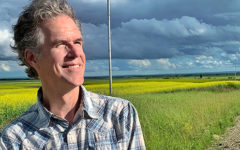
Hey Sonny, I would love to know if you have any memories/recollections of bass player Ernie Newton who was featured on so many Nashville sessions in the 1940s and ’50s, including many bluegrass recordings with Monroe, Flatt & Scruggs, The Stanley Brothers, and of course, with you Sonny.
Tom S.
Tom, thank you for joining us in our weekly free-for-all. You asked if I had any memories of Ernie Newton and, yes, I knew Ernie well. He played bass on the tracks I made with Bill Monroe in 1952. If I’m not mistaken, he was also on our first MGM session and he was the first guy I saw with an apparatus that resembled a drum head mounted on his bass. He could take a snare brush and it sounded a great deal like you had a bass and snare drum. Ernie was perhaps the number one bass player in Nashville until the emergence of Bobby Moore. Ernie was a nice man, a true gentleman, and he was always smiling and he was the same every time you saw him.
S.
—–
Hi, Sonny! I remember you were pretty annoyed when Rite Records released three albums’ worth of your early Kentucky and Gateway singles. No one asked for your input, and you felt all the sides worth reissuing could fit on one LP. Personally, I’ve always been fond of the eight 1953 sides you recorded soon after Bobby came back from Korea. But what tracks would you have chosen from those early efforts?
On another matter, do you prefer the stereo or mono mixes on your later MGM and early Decca albums? Were you and Bobby directly involved in the mixes back then? Thanks much!
Dave in Indiana
Dave in Indiana and Tom S. included, I welcome you to the most read column on Bluegrass Today. I’m proud of that, and some of you may take that as conceit, but that’s alright.
Rite Records released three albums of material, recorded just a month into my 14th year, and it sounded like that. Was I happy with that? As an adult, no I was not. And when Bobby came home from Korea, we recorded some pretty decent stuff. I was happy with that. That band on those 8 sides was pretty good.
As far as the earlier releases, there were 2 sides I was pleased with…one was Sunny Mountain Chimes and the other was Banjo Boy Chimes. When stereo was first introduced to our music, on MGM especially, they destroyed more than they helped. Decca Records was not in that same category. By then they had stereo down to a science. Bobby and I were not involved with mixing our music until about 1965. That’s not to say it was all bad because Pathway of Teardrops was a part of those sessions.
S
—–
Hey Sonny, I was wondering what do you think of the Gibson Brothers style of bluegrass singing? It seems they sound different from other bluegrass bands in their harmony and rhythm.
Also: Speaking on today’s bluegrass being weak country… seems like the way bands dress have gone the same way. I saw a member of a popular bluegrass band once show you their Kentucky Wildcats t-shirt, which they were wearing to the stage. You politely reminded them what people were there to see, pointing to your shirt and tie. Do you think there’s a correlation in dressing for the stage and the quality of music that band produces?
Wes Vanderpool (Krako enthusiast)
So now I’m having to deal with Wes Vanderpool, who is a KRAKO banjo enthusiast, and one hell-of-a banjo player.
I really like the Gibson Brothers’ choice of songs and arrangements. Although I’m not sure they want to be classified as 100% bluegrass.
Speaking on today’s bluegrass being weak country, I stand by that, solidly. When country entertainers started wearing blue jeans they had slept under a bridge in, with holes in the knees…bluegrass bands were surely to follow….and they did. So, a country guy, very popular, goes onstage with a wife-beater undershirt on, next thing I know I’m seeing a very popular bluegrass guy go onstage with a wife-beater undershirt on. In my opinion, this does not affect their music but I firmly believe it affects the quality of their audience because we are so far from the shirt and tie and suit days, so then how far are we from the bottle-throwing audience. And then, does this make sense to any of you? It does to me and it is a little bit scary, especially when a now-deceased well-known banjo player came up to me wearing a t-shirt that said, “Sex and drugs, Flatt and Scruggs.” And I told him “Son, I’d be ashamed to wear that.”
S
—–
Boys and girls and adult children all over this chaotic world…
I want to introduce you to a brand new band called The Tennessee Bluegrass Band, and also make you aware of a 32-yr old band that is playing some of the smoothest Bluegrass music you will hear this day and time.
The Tennessee Bluegrass Band consists of (guitar/vocal) John Meador, (bass/vocal) wife Gracie Meador, (mandolin/vocal) Tim Laughlin, the incomparable Lincoln Hensley playing the Krako banjo (like no other), and US and Canadian Grand Masters fiddle champion, Aynsley Porchak. These 5 people have just begun, and in my opinion, are going to be heard from on a major scale. They are that good. The Tennessee Bluegrass Band.
The old guy I was talking about, who in my opinion has assembled his best band, that would be The Larry Stephenson Band which consists of great original banjo playing (Krako #3) Derek Vaden, guitar/vocal Nick Dauphinais, a new guy named Andy playing bass, and of course Larry Stephenson on mandolin/vocal. They are smooth and very good. If you haven’t heard them recently….you should!
And I want to thank you for making this little experiment the most read, weekly column in Bluegrass Today. Thank you, thank you, thank you.
Sonny
If you have something you would like to ask Sonny, be sure to post it in the comments below, or send it to us directly.







